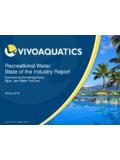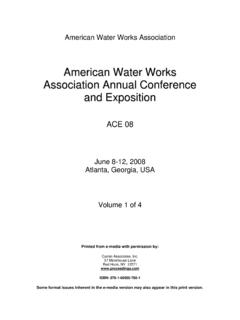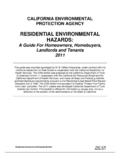Transcription of Recommendations for Cyanobacteria and Cyanotoxin ...
1 Office of water Office of water EPA 820-R-17-001 June 2017 Recommendations for Cyanobacteria and Cyanotoxin Monitoring in Recreational Waters 2 Foreword The purpose of this document is to provide EPA s Recommendations , information and process steps that a recreational water manager or public health official may choose to follow, or adapt, to aid in determining if there is a harmful bloom or cyanotoxins posing a risk to humans, pets, wildlife and livestock in a water body. This document provides EPA s monitoring Recommendations ; nonetheless, EPA has provided general information on these issues on the Cyanotoxin webpage, Monitoring and Responding to Cyanobacteria and Cyanotoxins in Recreational Waters.
2 For a stepwise conceptual Cyanotoxin monitoring program framework: Step 1: Assess vulnerability of the water body to HABs and prioritize recreational waters for monitoring; Step 2: Observe recreational water body for blooms at the beginning and throughout the recreational season; Step 3: Monitor for cyanotoxins; and, Step 4: Follow up Cyanotoxin monitoring. Disclaimer This document provides the EPA s Recommendations for Cyanobacteria and Cyanotoxin monitoring in recreational waters. These monitoring Recommendations do not impose legally binding requirements on the Environmental Protection Agency (EPA), states, tribes, or the public. These Recommendations also do not confer legal rights. These Recommendations do not constitute a regulation, nor do they change or substitute for any Clean water Act ( CWA) provision or the EPA regulations.
3 These Recommendations may not apply to a particular situation based upon the circumstances. Interested parties are free to raise questions about the substance of these Recommendations and the appropriateness of their application to a particular situation. The EPA retains the discretion to recommend approaches on a case-by-case basis that differ from those described in this document where appropriate. The EPA may revise this document periodically without public notice. The EPA welcomes public input on these Recommendations at any time. 3 How to Monitor Cyanobacteria /Toxins in Recreational Waters* *Adapted from Recommendations for Public water Systems to Manage Cyanotoxins in Drinking water June 2015, EPA 815-R-15-010 ** This can either be an advisory/warning or a closure.
4 **If yes, consider modifying notification to indicate dangerous toxin level or cell count. If toxins are present but less than appropriate trigger value, continue to monitor toxins. **If the state does not have a HAB program with a value for cyanotoxins or cell counts upon which to base a notification, recreational water managers may want to consider using the draft values that EPA recommends. 4 Recommendations for Cyanobacteria and Cyanotoxin Monitoring in Recreational Waters Step 1: Assess vulnerability of the water body to cyanobacterial blooms and prioritize recreational waters for monitoring Protecting public health is the primary objective for a monitoring program. To meet this objective, recreational water program managers and public health officials should make every effort to sufficiently characterize the water body to better understand the potential for harmful blooms, and thus the adverse public health risk that might occur in these waters.
5 Sometimes phytoplankton (which includes Cyanobacteria , microalgae, dinoflagellates and other microorganisms) can grow to high cell densities and form blooms. These blooms may or may not be toxic. This document focuses on cyanobacterial blooms with the potential for harmful cyanotoxins (also known as harmful algal blooms or HABs). A bloom can have extremely high cell densities of Cyanobacteria (extremely high densities are typically defined as greater than 20,000 to 100,000 cells per mL) (Loftin et al., 2008). Cyanotoxins are produced by some toxic-producing species and are not always released into the water . Harmful algal blooms could adversely affect people and animals, regardless of the presence of toxins. Exposure to elevated cyanobacterial cells densities has been associated to dermal effects such as skin rashes, ear and eye infections and gastrointestinal distress.
6 Harmful blooms are those that pose a health risk to people, either due to the presence of toxins or due to elevated densities. Assess vulnerability of the water body to cyanobacterial blooms Some recreational waters are more vulnerable than others based on the water body and water shed characteristics. Fast flowing, nutrient-poor rivers are less vulnerable than nutrient-rich lakes and reservoirs. Existing water quality data can help to determine if the water body has had a history of blooms or bloom indicators such as high cyanobacterial cell counts or chlorophyll-a levels. Elevated nitrogen and phosphorus levels will be important to consider in a waterbody evaluation. Waterbody assessments should consider the predominant land use in the watershed and potential nutrient sources that may lead to cyanobacterial growth for a system-specific evaluation.
7 Similarly, climate and weather information such as water temperature and intensity of precipitation events will help to determine if conditions are conducive to increased levels of site-specific cyanobacterial growth currently and in the future. A variety of information can be considered to assess the vulnerability of the recreational water to cyanobacterial blooms including: the type of water body; historical Cyanotoxin occurrence; weather data (increases in temperature, precipitation and light); seasonal patterns of cyanobacterial blooms; land use patterns; physical and hydrologic factors ( , turbidity, pH and nutrients, and residence time); chlorophyll-a and phycocyanin levels; point and nonpoint sources of contamination upstream; water quality impairments; and, any other information gathered as part of source water assessments or sanitary surveys.
8 EPA recommends that managers, public health officials, tribes and states evaluate available data on their recreational waters to assess waterbody vulnerability to cyanobacterial blooms. Specifically, available data can be evaluated against EPA s recommended values or their own state/s values to determine whether harmful blooms have occurred in the past. As a benchmark for evaluating the risk to public health in recreational waterbodies, EPA has released a draft document for public comment that provides Cyanotoxin values (Recreational AWQC/Swimming Advisory for Cyanotoxins). See Table 1. 5 Table 1. Draft EPA Recommended Values for Recreational Criteria and Swimming Advisories for Cyanotoxins Microcystins Cylindrospermopsin 4 g/L a,b 8 g/L a,b a) Swimming Advisory: not to be exceeded on any day b) Recreational Criteria for Waterbody Impairment: not exceeded more than 10 percent of days per recreational season up to one calendar year.
9 Although EPA has Recommendations for specific toxins, cell counts and/or biomass, together with microscopic identification can be informative and an interim step to make public health decisions and/or prompt toxin analysis. The Global water Research Coalition, a non-profit organization for water research, published voluntary guidelines in 2009. The International Guidance Manual for the Management of Toxic Cyanobacteria provides information on many topics including cell enumeration, and calculation of biovolume/biomass. The World Health Organization (WHO) established guidelines for cyanobacterial cells (see Table 1) and several states ( , Connecticut, Indiana, Kentucky, Oklahoma, Utah, Wisconsin) use them for their swimming advisory level.
10 Table 2. WHO (2003) Recreational Guidance/Action Levels for Cyanobacteria , Chlorophyll a, and Microcystin Relative Probability of Acute Health Effects Cyanobacteria (cells/mL) Chlorophyll a ( g/L) Estimated Microcystin Levels ( g/L)a Low < 20,000 < 10 < 10 Moderate 20,000 100,000 10 50 10 20 High >100,000 10,000,000 50 5,000 20 2,000 Very High > 10,000,000 > 5,000 > 2,000 aWHO (2003) derived the microcystin concentrations from the cyanobacterial cell density levels. Prioritize recreational waters for monitoring. Recreational water managers, public health officials or state water quality staff should develop a risk-based monitoring plan for recreational waters that are potentially vulnerable to blooms in order to prioritize their monitoring resources by considering the following information: Existing and historical recreational water quality, Sampling considerations, Analytical methods, Sampling/testing logistical considerations, Use of predictive tools and satellite data (see Section ), and Frequency and number of people using the recreational water .















